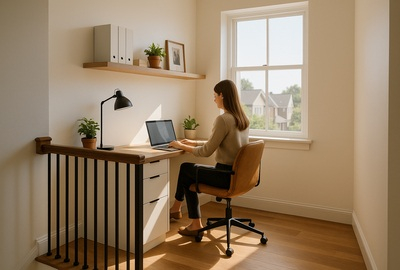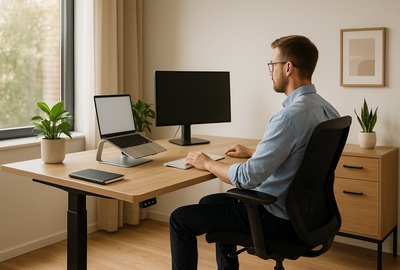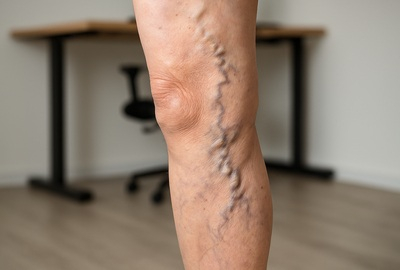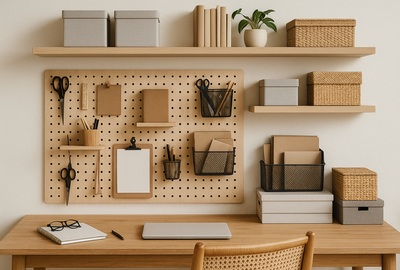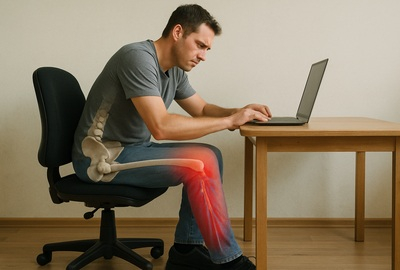- Home Office Lighting Ideas: Brighten Your Workspace
- 1. The Best Home Office Lighting Ideas That Actually Work
- 2. Ambient Lighting Basics: How to Layer Light Like a Pro
- 3. Best Light Sources for Long Hours of Computer Work
- 4. Desk Lamps That Do More Than Just Light Up Your Desk
- 5. Let the Sunshine In: How to Maximise Natural Light at Home
- 6. Ceiling Lights vs Floor Lamps: What Belongs in Your Home Office?
- 7. Budget-Friendly DIY Lighting Ideas That Look High-End
- 8. Ready to Revamp? Your Guide to the Best Home Office Lighting Setup
- Final thoughts
Home Office Lighting Ideas: Brighten Your Workspace
There’s a big difference between working from home and actually being productive at home. And if you’ve ever found yourself squinting at a screen or shifting around to avoid a glare, chances are your lighting setup is holding you back.
The right lighting doesn’t just illuminate your desk—it shapes your focus, supports your well being, and even impacts how you show up in video conferences. Whether you’re in a converted spare room, an open-plan corner, or a studio apartment, this guide walks through practical, real-world home office lighting ideas that work. Think function first, then style. Always.
1. The Best Home Office Lighting Ideas That Actually Work
So, what really makes for the best home office lighting? It comes down to layering. That means using multiple light sources to handle different tasks—and yes, avoiding that one lonely bulb that casts harsh lighting and leaves half your room in shadow.
- Ambient lighting: The general glow. This could come from ceiling lights, pendant lights, or a bright floor lamp placed strategically to light the whole space.
- Task lighting: The focused beam. Use a desk lamp for desk work, reading, or anything that needs precision.
- Accent lighting: The style factor. This adds visual interest and softens harsh edges. Think wall sconces, LED strip lights, or a small table lamp.
If you’re working with low ceilings, avoid bulky fixtures. Flush-mount or recessed ceiling lights give you enough brightness without crowding the space. And for long hours, make sure your setup supports good posture and limits eye strain—a mix of warm and bright light throughout the day helps avoid fatigue.
To avoid the adverse effects of poor lighting—like headaches or early burnout—use direct task lighting that points exactly where you need it, without bouncing into your eyes or screen.
2. Ambient Lighting Basics: How to Layer Light Like a Pro
Ambient lighting sets the mood and gives the space structure. It’s not meant to light your screen directly—it’s meant to make the room feel consistent and inviting.
- Pendant lights over your workspace to create a clear zone of focus
- Ceiling lights with a dimmer to control brightness during different times of the day
- Soft floor lamps to wash the walls with light and reduce shadows
Layering ambient light with task lighting gives your eyes a break and avoids the disorienting contrast between a bright screen and a dark background. When you only light your keyboard and let everything else go dim, you’re inviting eye strain, poor posture, and fatigue.
Pro tip: Bounce light off light-colored walls and ceilings for more even coverage. This helps prevent cast shadows behind you, which can make you look flat and dull in video conferencing. A well-planned mix also ensures even distribution of light across your space, making it feel more comfortable.
3. Best Light Sources for Long Hours of Computer Work
If you're spending all day in front of a screen—and who isn’t these days?—your lighting has to do more than just look good. You need a setup that works with your monitor, not against it.
- Color temperature: Choose white light in the 4000K–5000K range. It mimics daylight and keeps your brain alert.
- Dimmable controls: Adjust brightness depending on time of day or what you're working on.
- Angle matters: Avoid placing direct light sources behind your screen or straight into your eyes.
Use desk lamps that can be tilted and rotated. Place them so they throw light across the workspace, not straight down, to avoid glare or hot spots. Behind your monitor, a strip of LED strip lights creates a soft glow that reduces contrast and eye strain.
When the lighting’s off, you notice. Your shoulders hunch, your head tilts, and you finish the day feeling like you ran a marathon. Not good. Investing in proper task lighting fixes this fast. If your home office doubles as part of a shared space or serves as one of your other rooms, adaptable lighting becomes even more essential.
4. Desk Lamps That Do More Than Just Light Up Your Desk
If there’s one piece of lighting gear that pays off big, it’s a proper desk lamp. You’ll use it every single day, so make it a smart pick.
- Articulated arms or goosenecks: So you can position the light exactly where you need it
- Adjustable brightness: Because you’ll want different settings for late-night emails vs. early Zoom calls
- Built-in controls: Touch dimmers, timers, and even wireless charging pads are common now
Placement is everything. Position the lamp opposite your writing hand to avoid casting shadows. And aim it across the desk, not down at it—that way you’ll illuminate your tools without making your screen unreadable.
Beyond function, think style. A matte black lamp with brass accents? Sharp. A minimalist white LED lamp on a clean desk? Also great. Your lamp doesn’t just help you see—it helps create the vibe you want.
5. Let the Sunshine In: How to Maximise Natural Light at Home
There’s no replacement for natural light. It’s free, it’s beautiful, and it’s the most effective way to keep your energy up through long days.
- Desk placement: Sit adjacent to a window rather than in front or behind. This keeps glare off your screen and light out of your eyes.
- Reflective materials: Use light walls, glass surfaces, or mirrors to help bounce light deeper into the room.
- Window treatments: Soft blinds or curtains help manage brightness without blocking the whole view.
Working near a window is also good for mental health—it helps regulate your body clock and lifts your mood. Just be careful during peak sun hours. Midday bright light can cause harsh lighting and unflattering shadows in video conferences.
Mix in a soft light source, like a side lamp, to keep things balanced on overcast days. You want consistent, diffused light—not extremes.
6. Ceiling Lights vs Floor Lamps: What Belongs in Your Home Office?
Should you go overhead or ground-level with your lights? The answer depends on your layout and how often your space has to shift roles.
Ceiling lights are best when:- You want to keep floor and desk space clear
- You need strong general lighting that fills the entire room
- You have a permanent or semi-permanent setup
- Your office is part of a shared or multi-use room
- You want flexibility to move things around
- You need to illuminate darker corners or highlight a reading chair
Look for floor lamps with multiple heads or adjustable arms—great for accent lighting or layering over your existing lights. And if you're working in an open-plan space or a tight area, choose slender, vertical designs that won’t crowd your workspace.
Pairing both types often works best. Overhead lighting gives structure and consistency, while floor lamps provide direction and warmth.
7. Budget-Friendly DIY Lighting Ideas That Look High-End
Good lighting doesn’t have to cost a fortune. You can find sleek, functional pieces that upgrade your office without draining your account.
- LED strip lights: Line the back of your monitor or under shelves. It adds glow, depth, and helps reduce glare.
- Vintage finds: Thrift stores are goldmines for solid lamps—swap in modern light bulbs for that updated look.
- DIY projects: Mason jar pendants, upcycled desk lights, even clip-on spotlights can add personality without feeling cheap.
Want to add visual interest without committing to hardwiring? Use picture lights or battery-powered sconces to highlight bookshelves or artwork.
The secret is in placement and layering. A few well-placed lighting fixtures will always look more thoughtful than one bright overhead. You don’t need a designer budget—just a clear plan and the right bulbs.
8. Ready to Revamp? Your Guide to the Best Home Office Lighting Setup
Feeling ready to give your space the glow-up it deserves? Here's how to create a lighting setup that works for every kind of task—and looks good doing it.
Step 1: Assess your space- Identify dark corners, shadows, or glare spots
- Note how natural light changes throughout the day
- Consider where you spend most of your time in the room
- Use general lighting like ceiling lights or pendant lights for overall brightness
- Add task lighting such as adjustable desk lamps
- Soften the edges with ambient lighting and accent lighting
- Use dimmers or smart controls to shift lighting with your workday
- Place lights at multiple heights to create depth and avoid cast shadows
- Check how your lighting looks on camera—especially important for virtual meetings
- Mix warm and cool tones depending on the time of day
- Use light to highlight your space’s style
- Keep your setup flexible for different tasks
By doing this, you not only reduce eye strain, you build a workspace that feels energizing, not exhausting. It’s the kind of environment you want to walk into each morning—and that you feel good walking away from at the end of the day.
Final thoughts
Your lighting should work just as hard as you do. Whether you’re managing a full-time remote gig, freelancing between clients, or juggling work while raising kids, the right home office lighting turns a stressful day into a smooth one.
And when it’s time to get the tools to match your setup—Deskup is here for it. We offer more than just desks. Our range of ergonomic frames, desk accessories, and lighting-friendly configurations are designed to support real people doing real work.
Need help finding a solution that fits your workspace, lighting needs, and budget? Reach out. We’re stocked in Australia, ready to ship, and ready to help you make your office not just workable—but ideal.


 Buy Now, Pay Later
Buy Now, Pay Later Verified Rating
Verified Rating 


